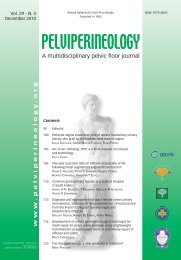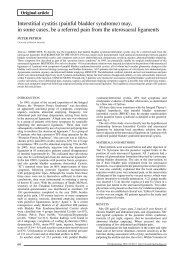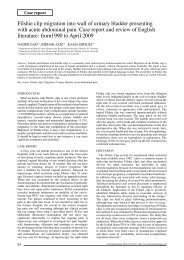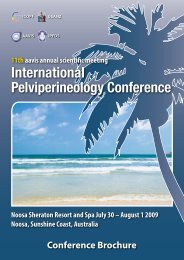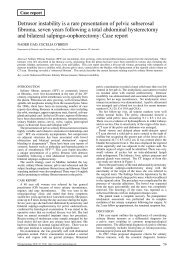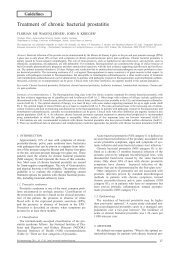Bilateral iliococcygeus fixation technicque for ... - Pelviperineology
Bilateral iliococcygeus fixation technicque for ... - Pelviperineology
Bilateral iliococcygeus fixation technicque for ... - Pelviperineology
Create successful ePaper yourself
Turn your PDF publications into a flip-book with our unique Google optimized e-Paper software.
H. Krissi - S.L. Stanton<br />
<br />
patient needed a blood transfusion <strong>for</strong> preoperative anemia<br />
that become symptomatic postoperatively. Shull et al 10 and<br />
Meeks et al 11 <br />
<br />
et al 12 <br />
<br />
<br />
<br />
<br />
<br />
<br />
<br />
rectocele grade 2, 1 rectocele grade 1, and 2 cystouretrocele<br />
<br />
intraoperative re-assessment precluded surgery <strong>for</strong> these<br />
sites. Two other patients had deterioration of an existing<br />
prolapse, and only one patient had a denovo prolapse. The<br />
patient characteristics of the failed group were similar to<br />
those of the successfull group.<br />
<br />
<br />
in patients with multiple-site prolapse who had rectocele<br />
or cystocele grade 1 or less.<br />
<br />
with previous surgery <strong>for</strong> prolapse.<br />
<br />
Non-absorbable sutures or polydioxanone suture may be<br />
a better choice.<br />
<br />
<br />
spines inferior to the normal position of the vaginal apex.<br />
This may result in shortening of the vagina, as shown in our<br />
<br />
<br />
in order to decrease the risk of recurrence. However, in a<br />
potentially sexually active woman, attention should be<br />
directed leaving a functional vaginal length.<br />
CONCLUSIONS<br />
<br />
effective vaginal surgery <strong>for</strong> the treatment of vaginal vault<br />
prolapse and enterocele. Ef<strong>for</strong>ts should be made to correct<br />
all additional site of prolapse and to maintain an adequate<br />
vaginal length in sexually active women. The grade of<br />
prolapse should not be altered during surgery. In cases of<br />
secondary repair, a mesh interposition should be considered.<br />
Long-term follow-up is needed <strong>for</strong> further evaluation of this<br />
technique.<br />
<br />
<br />
<br />
2. Sze EH, Karram MM, Transvaginal repair of vault prolapse: a<br />
<br />
-<br />
<br />
4. Bump RC, Mattiasson A, B0 K, Brubaker LP, DeLancey JOL,<br />
Klarskov P, Shull BL, Smith ARB. The standardization of terminology<br />
of female pelvic organ prolapse and pelvic floor dys-<br />
<br />
nal<br />
reconstructive surgery <strong>for</strong> the treatment of pelvic support<br />
defects: a prospective randomized study with long term out-<br />
<br />
<br />
Pelvic support defects and visceral and sexual function in women<br />
treated with sacrospinous ligament suspension and pelvic recon-<br />
cussion<br />
1430-1<br />
<br />
postoperative analysis of site-specific pelvic support defects in<br />
<br />
<br />
<br />
<br />
<strong>Bilateral</strong> uterosacral ligament vaginal vault suspension with sitespecific<br />
endopelvic fascia defect repair <strong>for</strong> treatment of pelvic<br />
<br />
<br />
<br />
<br />
<br />
of the vaginal cuff to <strong>iliococcygeus</strong> fascia: An effective method<br />
<br />
<br />
of vaginal vault prolapse by suspension of the vagina to ili-<br />
<br />
<br />
<br />
<br />
40-4.<br />
Acknowledgment: The authors wish to thank Professor Martin<br />
<br />
data processing and statistical analysis.<br />
Correspondence to:<br />
Dr. HAIM KRISSI<br />
<br />
<br />
Israel<br />
<br />
<br />
E-mail: haimkrissi@hotmail.com<br />
14



